46 Post Convertible
1989
by David Pascoe
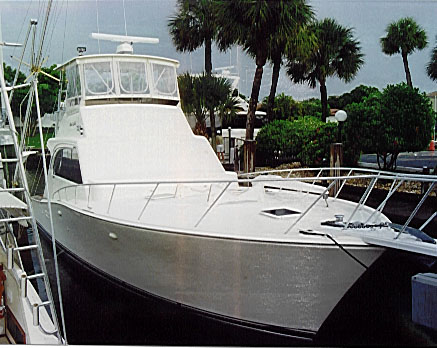
Well, folks, I did it again. I sold a sport fisherman as a cruising boat. To a former sailor, no less. Yeah, a rag boater! This is the guy who was looking at the 45' Hyatt I told you about. Quite a change in thinking.
Mind you, I get a little leary about making recommendations to people, since one man's treasure is another man's trash. But I said at least you ought to have a look see, anyway. A floating condo it is not, but its got other advantages you may not have thought of. What really changed his mind though was the decision that he didn't want to bring along a lot of friends on his boating trips to the Bahamas. Occasionally another couple, but holding up in a marina-side hotel frequently. These are great boats for two people, and not bad for four. But with everyone up front, no kids, thanks.
Of course, the going up and down on that bridge ladder is a royal pain. Can't argue with that at all. But you can argue that there is only ONE up-and-down, unlike four of them on motor yachts. Something to be said for that. And once you're off the bridge, you've got nice clear decks. No junk to fall over. But no enclosed veranda. No patio bar. And not a lot of enclosures to replace every few years.
Post. Its hard to put your finger on why these boats seem so different from all others of her class, but she is. You don't mistake comparing her with Bertram or Hatteras, and if anything she's similar to an Ocean -- without all the problems. Don't choke, you Post owners. Sweeping sheerline, wide at the deck, much narrower at the water line, it looks bigger than it is. Especially inside. Aft section tapering fairly strongly at the stern with a pronounced vertical flare at the sides. A wide boat designed for a narrow water line and low wetted surface area. And the bottom, I've always thought, was much too flat. More about that later on.
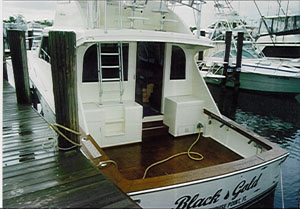
The teak deck was an add-on. Nothing to complain about here . . . .
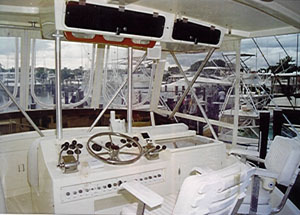
. . . or here
Old fashioned, semi-classical styling, these boats don't go out of style and become stylistic clunkers. Helps keep the price up there. Yet, stylistically, something is not quite right. Hard to put your finger on it, but when you look at a 46 Berty, you know it for sure. All the lines work in near-perfect harmony on the Berty, whereas there a few things are out of kilter on this one. Like the lack of a forward windshield eyebrow. Even so, the basic design hasn't changed in 20 years, but it doesn't make you think of a 1969 Mercury Comet.
But never mind. In this era of high-priced junk boats, the Posty's have something going for them. For if Post is notable for anything, it is that they have achieved the right mix of quality and economy. Price-wise, Post is just off the high end while creating a yacht that is tough and durable. Or perhaps I could say that it is a high end "price" boat. Sounds silly, but that's not inaccurate. Its all about making intellegent choices between what is needed and what isn't.
For a long time Post has been cutting corners in places where its more or less okay to cut them. What you get is high quality materials, but you get less of it. You discover this when you start comparing her with her competition and you starting finding that certain things are missing. Redundancy is not there, bits of hardware here and there, doubling up on systems use, fewer sea cocks and strainers, a bit less in cabinetry, and so on. In other words, instead of giving you a bunch of cheap shit, many of the extra ooh aahs are just not there. Like instead of giving you 8 cheap plastic light fixtures, you only get four good ones. That sort of thing. And that's the way it should be.
If they give you a garbage salt water washdown system and it breaks down in a year, you are pissed off at the builder. If you don't get one at all, you're not. Especially if you added a cheap one yourself. Your choice, guy.
But you do get those great Galley Maid Delta head systems that are just wonderful. Expensive, too. Big, powerful pumps that work right and will dispose of a gorilla turd without throwing it back in your face. Expensive but worth every penny. Own one of these systems and you'll never tolerate anything else.
For air conditioning, it has 10 & 16 K BTU units. It was cool and rainy (only 88 degrees instead of the usual 95), with periods of sun, and I thought the cooling capacity was marginal for Florida. The salon needs 24K. But at least the compressors are in the engine room and not under your bed. Zero noise.
Engine Room The engine room, a compartment really, is kinda weird. Since a member of my family owned one of these boats for many years, I know it well. Its got two 300 gallon aluminum fuel tanks on the centerline sitting up high. A bit too high without lifting the hatches, as crawling around down there without lifting them is a bit, shall we say, uncomfortable? But hatches, Wow! They're huge, and when you take them up you can get at everything sooper dooper. A mechanics dream. See photo below. No excuses for you not keeping the engine room looking as nice as this one!
The engines are on Ace mounts, no puny, crapola Bushings, Inc stuff. They cost about $250 a piece, so that's 2 grand for mounts. See what I mean about quality in the right places? But its either that or bust up a $6,000 gear box eventually. "Pay me now or pay me later," sez Mr. Goodwrench.
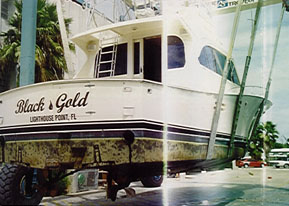
Yes, its pretty flat.
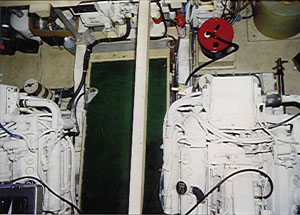
When you pull the hatches, which is easy to do, this is what kind of access you have.
The generator's down there too, so it won't turn into a ball of rust under the cockpit where it will get wet.
No, everythings not as neat as a pin, but good enough not to be sloppy. I could live with it, though I'm a neat freak. There are no internal sea strainers on the engines, another clipped corner. A good $2k to install them.
Most of these 46's come with DD 6V92TIBs at 550 hp, although earlier models (up to mid 1980's) had overpowered 6-71's squeezing 435 hp out of them. That is too much for that engine and they don't hold up well. The 92's have a 1:1 c.i.d to horsepower ratio, which places it right at the limit of how much power you can get out of the engine while not excessively reducing engine life. Treat them nice and they should do fine. Hot rod them and you pay and pay.
Big mufflers keep the exhaust pretty quiet.
I guessed she'd top out at 30 but only managed 28 with original size props. In any case, she's a speed demon. We had a nasty 3' sea going out in the stream with the crests spaced well out. While she did not slam, she's no Hatteras either. The 45 Hat I did last month under similar conditions rode smoothly, pushing the seas out of her way with sheer weight and power. This boat shuddered a bit and the sea let you know it was the master of ceremonies this day. But that's what a Post is, folks. She'll go like hell on a nice day, but when it isn't so nice, you've got to throttle back. At a 21 kn cruise the bucking bronco tendencies disappeared.
At a whopping 10,000 lbs lighter than a Berty or Hat, you'll definitely save a few bucks on fuel. She trims out fine and the tabs aren't even needed.
Structural The hull is well framed and it has no record of structural problems. Some of these boats are known to blister, and this one recently had some spot blister repairs, but otherwise no big deal. The hull is solid glass and the decks are balsa cored with no problems. Things are largely done right. Rudders are a little on the small side. House structure is solid, windows don't leak. A number of these boats survived hurricane Andrew just fine when neighbors didn't. Check out the photo below.
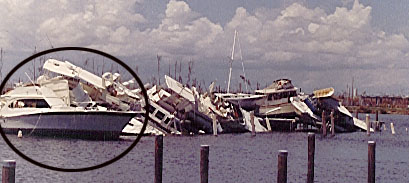
Interesting Photo: Hurricane Andrew. Every boat on this dock is wrecked except the Post 46. Luck or what?
Inside The standard layout is galley up. Well, almost. Actually it is one step down from the salon which is largish for this size boat. Under the sole there is a big empty space that was filled with a washer/dryer. The galley is a wee bit on the cramped side with not enough counter space. The upright, double door reefer takes up too much space. Be nice to have SubZero compact units here because you don't need the icemaker, or all that freezer space with the bait freezer back aft. It has an "L" shaped settee opposite which comfortably seats 3, not four. You can use the counter/divider between salon and galley for eating if necessary. Up under the windshield there's storage cabinets on the galley side and a built in entertainment center on the opposite side, but the design only allows for an 18' television. It comes standard with a lightweight, removable "L" settee in the salon which has convenient storage under.
The one serious drawback of this boat is the narrow beam at waterline. The super wide beam at deck level gives the appearance of a lot of interior space, but you find your feet have a lot less room than your head. The central companionway is slightly angled and a bit cramped, as are both staterooms. The master and guest heads are adequate but there are a lot of clashing doors in the forward quarters.
The interior is all done in teak veneer, the quality of which is middle of the road. If you love beautiful teak work, buy a Viking. Hardware is limited but good quality. After 8 years of hard use, everything has held up well. The interior does not look well used. Headliner is ultrasuede and most of the cabinets are well lined with reasonable access for plumbing, etc.
It comes with a single 50 amp, 250 VAC shoreline and Cablemaster. No 125 VAC lines. The main panel is smallish without hundreds of buttons and switches. Electrically, this boat is simplistic, and that's not all bad if you don't like to be always fixing things. Not a lot to go wrong.
The bait and tackle center is well done and looks nice to boot. It is laking in drawers though. There is almost no hardware on the outside to take care of. The cockpit has a full liner with no cabinets along the sides to cause maintenance problems. Just plain, flat fiberglass that's easy to keep clean. The transom door isn't falling off, either.
The bridge area is equally plain, but what really sets it apart is a rugged, well made hard top and fiberglass overhead electronics cabinet. Very sturdy. No nasty corroding aluminum here. NO WOOD. The ladder up to the bridge . . . well, its too steep. Needs a few more degrees of angle to be comfortable. The bridge is on the smallish side, but at least there is plenty of room to get around the two helm chairs. There's nothing more inconvenient than not being able to get by these chairs without asking the driver to move out of the way. Ergonometrically, everything is fine.
For many, it is the simplicity of this boat that is its strongest appeal. It is probably the least complex of any in its class. The people at Post certainly don't try to wow you with ooh aaahs.
The superstructure on this boat had just been painted and it looked . . . . well, not 8 years old. No, it looked one or two years old. An excellent choice for the maintenance and economy minded who'd rather spend their money on having fun than paying to fix a lot of broken goodies. Plus you can hold your own at the bar with those Bertram, Viking and Hatteras snobs because its damn near as good.
And speaking of value, get this: this boat retailed new for around 400, the 45 Hatteras sticker shock at 500 and Bertram 46 at 515. And she just sold for 75% of original cost. You won't see numbers like that very often.
Posted September 30, 1998
 Visit davidpascoe.com for his power boat books
Visit davidpascoe.com for his power boat books 


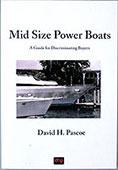







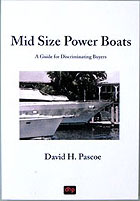
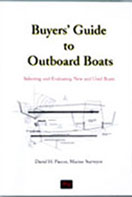

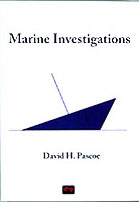
David Pascoe is a second generation marine surveyor in his family who began his surveying career at age 16 as an apprentice in 1965 as the era of wooden boats was drawing to a close.
Certified by the National Association of Marine Surveyors in 1972, he has conducted over 5,000 pre purchase surveys in addition to having conducted hundreds of boating accident investigations, including fires, sinkings, hull failures and machinery failure analysis.
Over forty years of knowledge and experience are brought to bear in following books. David Pascoe is the author of:
In addition to readers in the United States, boaters and boat industry professionals worldwide from nearly 80 countries have purchased David Pascoe's books, since introduction of his first book in 2001.
In 2012, David Pascoe has retired from marine surveying business at age 65.
On November 23rd, 2018, David Pascoe has passed away at age 71.
Biography - Long version